AMD Ryzen Threadripper 3990X Linux Benchmarks
For this exercise, we are using our legacy Linux-Bench scripts which help us see cross-platform “least common denominator” results we have been using for years as well as several results from our updated Linux-Bench2 scripts. At this point, our benchmarking sessions take days to run and we are generating well over a thousand data points. We are also running workloads for software companies that want to see how their software works on the latest hardware. As a result, this is a small sample of the data we are collecting and can share publicly. Our position is always that we are happy to provide some free data but we also have services to let companies run their own workloads in our lab, such as with our DemoEval service. What we do provide is an extremely controlled environment where we know every step is exactly the same and each run is done in a real-world data center, not a test bench.
We are going to show off a few results, and highlight a number of interesting data points in this article.
Python Linux 4.4.2 Kernel Compile Benchmark
This is one of the most requested benchmarks for STH over the past few years. The task was simple, we have a standard configuration file, the Linux 4.4.2 kernel from kernel.org, and make the standard auto-generated configuration utilizing every thread in the system. We are expressing results in terms of compiles per hour to make the results easier to read:
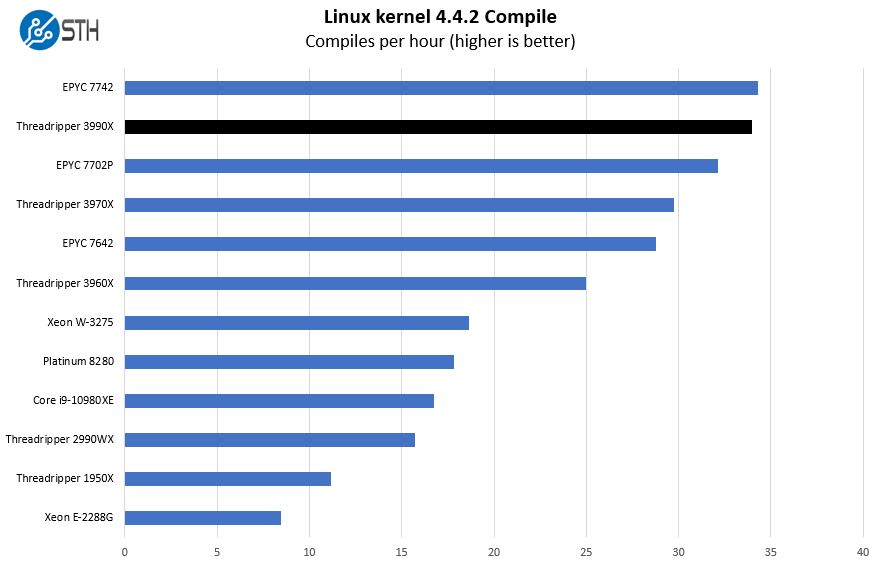
Here we can see an excellent performance. Although there are memory bandwidth constraints with 4-channel v. 8-channel performance on EPYC, and cores eventually are getting throttled, we can see performance well beyond the Intel Xeon W-3275 as well as some of the 48 and 64 core EPYC offerings.
c-ray 1.1 Performance
We have been using c-ray for our performance testing for years now. It is a ray tracing benchmark that is extremely popular to show differences in processors under multi-threaded workloads. We are going to use our 8K results which work well at this end of the performance spectrum.
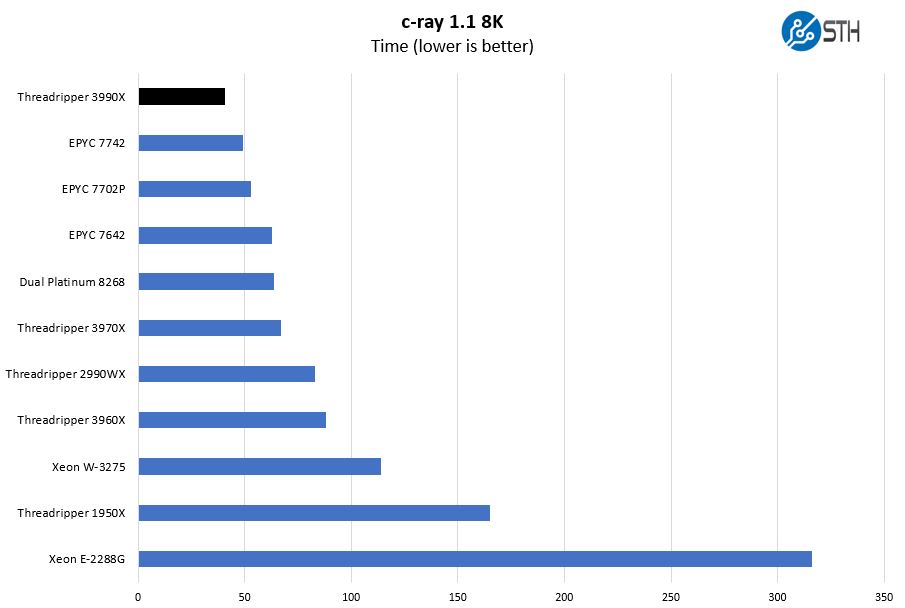
Our c-ray 8K benchmark was originally designed because the 4K render iteration was being completed too quickly. Here, we can see that the 8K version is quickly approaching that level with the Threadripper 3990X. Rendering is a workload that the Threadripper 3990X is specifically designed to address. It is little surprise that we are seeing it perform exceedingly well here. Just note how it is significantly ahead of the dual Platinum 8268 results.
7-zip Compression Performance
7-zip is a widely used compression/ decompression program that works cross-platform. We started using the program during our early days with Windows testing. It is now part of Linux-Bench.
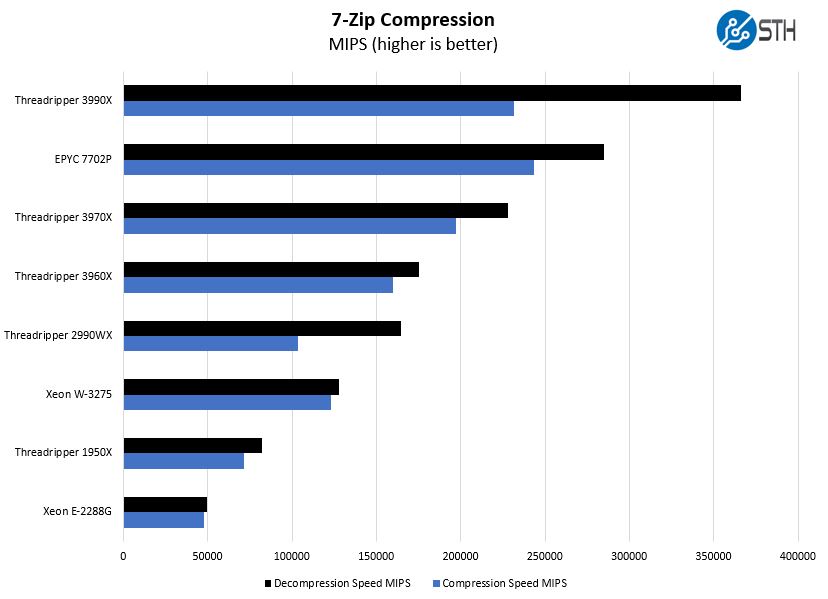
Compression speeds are good, however, one can see the impact of the 64 core parts hitting certain architectural limits.
NAMD Performance
NAMD is a molecular modeling benchmark developed by the Theoretical and Computational Biophysics Group in the Beckman Institute for Advanced Science and Technology at the University of Illinois at Urbana-Champaign. More information on the benchmark can be found here. We are going to augment this with GROMACS in the next-generation Linux-Bench in the near future. With GROMACS we have been working hard to support Intel’s Skylake AVX-512 and AVX2 supporting AMD Zen architecture. Here are the comparison results for the legacy data set:
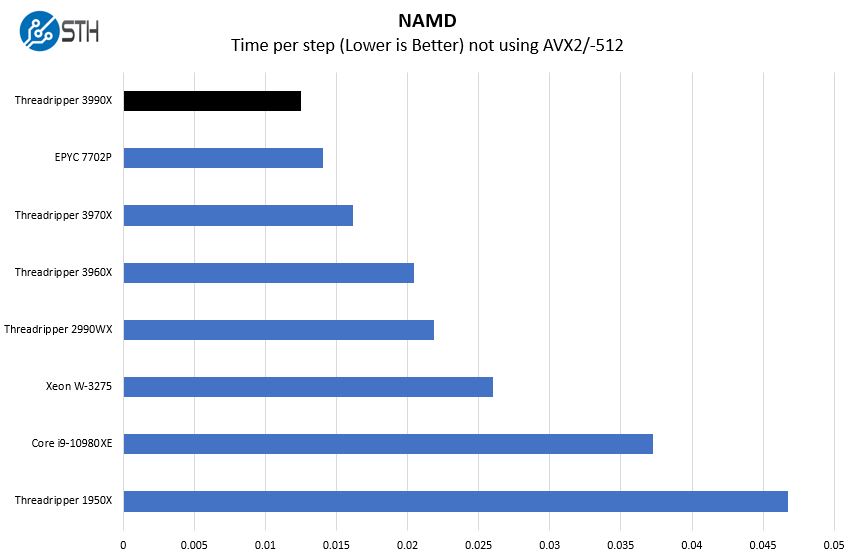
Being able to utilize a large number of cores, and keeping those cores at high clock speeds helps here. We should note that on a power efficiency basis, the EPYC 7702P is actually on top here.
Sysbench CPU test
Sysbench is another one of those widely used Linux benchmarks. We specifically are using the CPU test, not the OLTP test that we use for some storage testing.
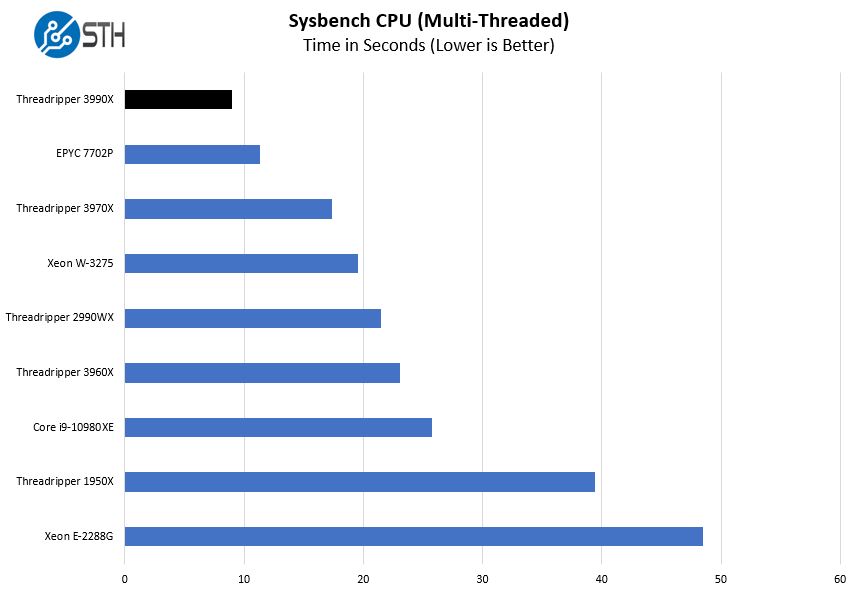
Sysbench in some ways follows the performance trajectory of rendering benchmarks. As a result, we see solid performance much as we do in Windows and Linux rendering benchmarks here.
OpenSSL Performance
OpenSSL is widely used to secure communications between servers. This is an important protocol in many server stacks. We first look at our sign tests:
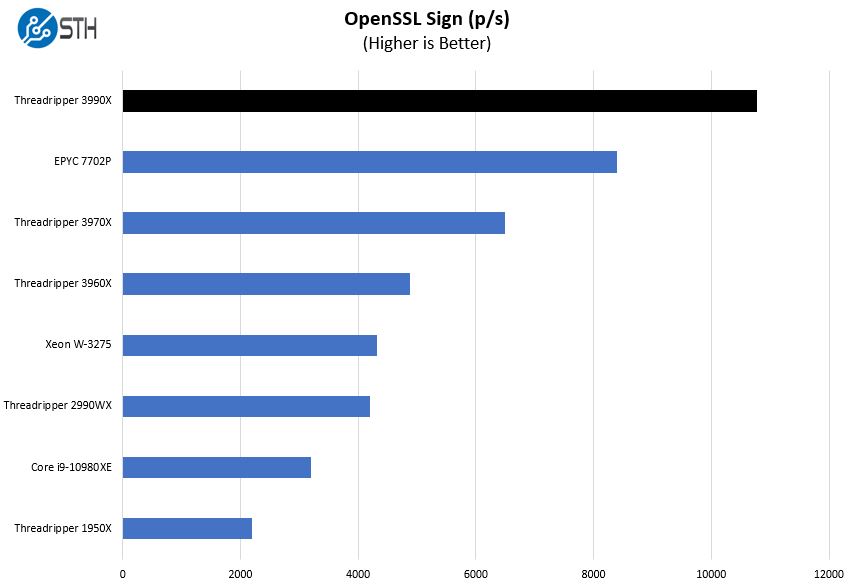
Here are the verify results:
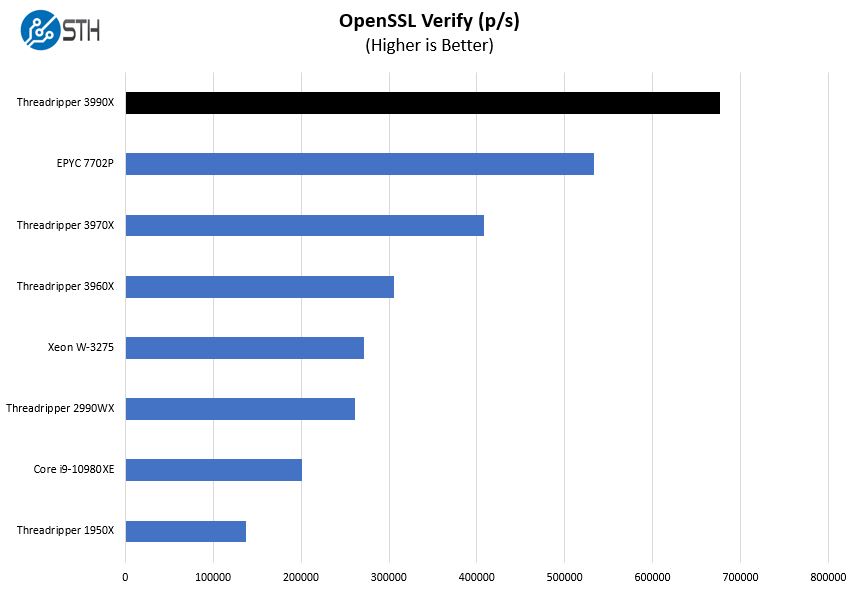
Here, performance is again absolutely top-notch. The high clock speeds and many cores make this a great performer. It should also make all of the server buyers want to have access to the AMD EPYC 7H12.
UnixBench Dhrystone 2 and Whetstone Benchmarks
Some of the longest-running tests at STH are the venerable UnixBench 5.1.3 Dhrystone 2 and Whetstone results. They are certainly aging, however, we constantly get requests for them, and many angry notes when we leave them out. UnixBench is widely used so we are including it in this data set. Here are the Dhrystone 2 results:
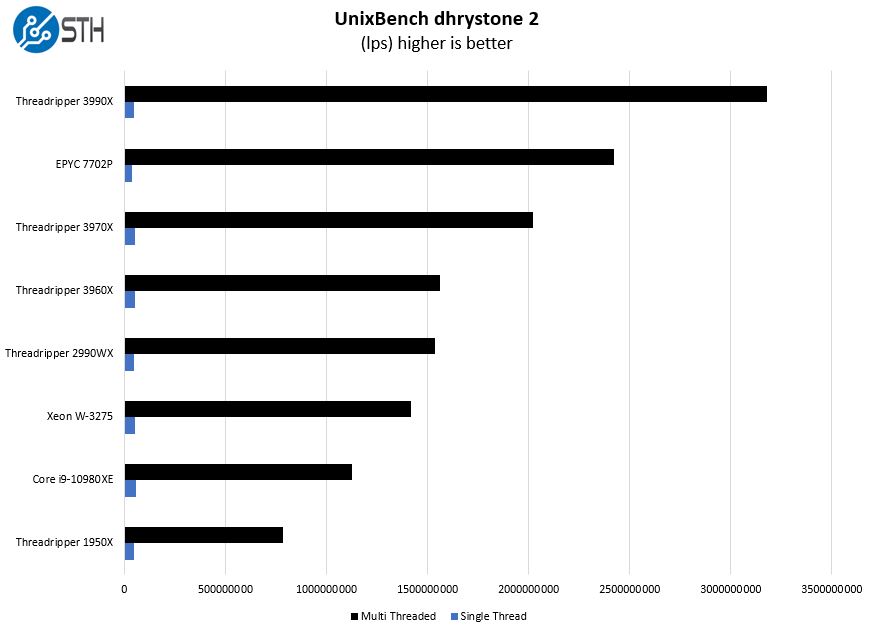
Here are the whetstone results:
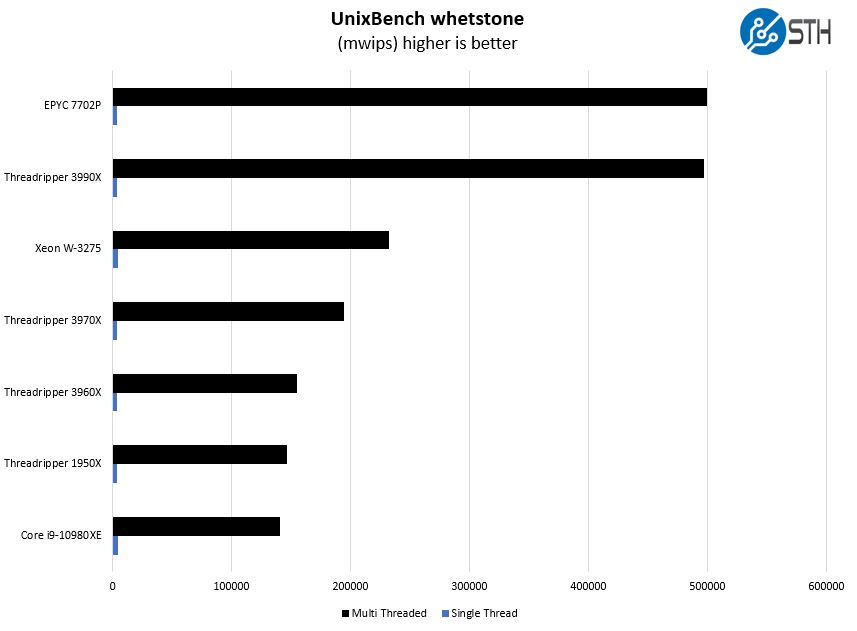
It is going to be very difficult to see here, but the Threadripper 3990X is actually a bit slower on a per-core basis. At the same time, having so many cores helps performance considerably. We need to do a bit more investigation into why we are seeing as big of a delta as we are on the whetstone side.
Chess Benchmarking
Chess is an interesting use case since it has almost unlimited complexity. Over the years, we have received a number of requests to bring back chess benchmarking. We have been profiling systems and are ready to start sharing results:
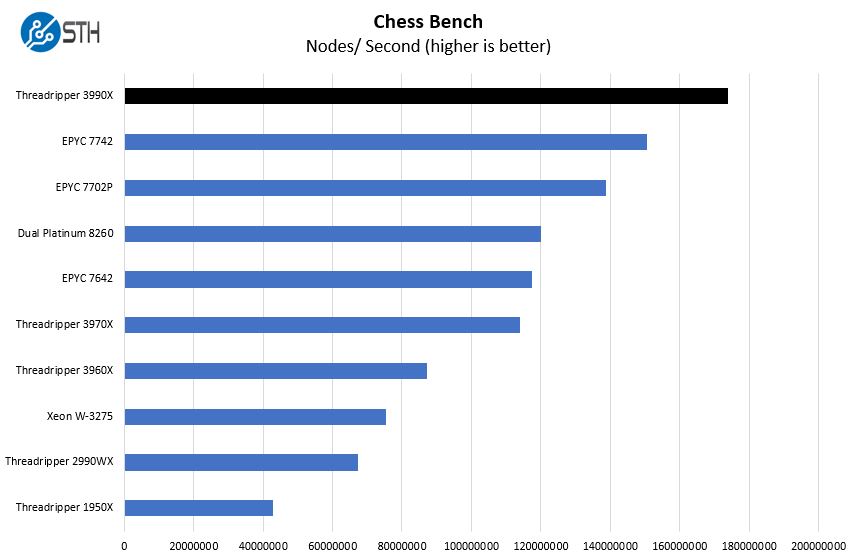
Chess is another application that can use the higher clock speeds of the 3990X along with all 64 cores very effectively. This is going to become a go-to for those who work on chess engines.
Next, we are going to look at the power consumption before getting to our final thoughts.

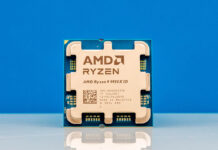


Good review & analysis. Thanks, John!
You guys are awesome, thanks!
I know it’s an ad, but the point made in the “Red Digital Cinema gets 64-Core Performance” video is what makes these CPUs so important:
Jarred Land: When I see this, how fast it is, it lets me get a liiiiiittle bit more aggressive with what we’re going to do next. With what we have on our roadmap, please, keep going, keep going, because we’re gonna need it.
Everything is connected. You can’t push the boundaries in one field if the technology in another is lacking.
Shouldn’t you test the pci express bandwidth with a gen 4 capable card?
Best use of Legos in all the 3990x reviews
Great review, John.
Just a thought/suggestion for a future article: It’d be great to see a round up of these workstation CPUs benchmarked with 16, 32, and 64 threads loaded. Particularly given how the higher end models can be quite a lot better binned silicon and how the CPU boosting technologies are implemented. It’d be really interesting to see the power draw and performance to see if the higher end models perform similarly at less power at moderate loads. I know previously it’s sometimes been better and cheaper, TCO wise, to buy the more expensive models for finish quicker then sleep efficiency advantages and also the better silicon – am curious if this might be the case for the 3990X.
According to Anandtech, you need Windows for Workstations to be able to use more than 64 threads effectively. I don’t see this being commented on in this article. Has that Windows version been used for the testing?
@Nikolay
you can use more than 64t but consumer versions partition it into processor groups thinking they are on separate sockets. However someone had mentioned that his Windows Pro machine only sees one socket in the task manager so I don’t know. Maybe it’s due to firmware or uefi settings? Or a much more recent update/patch or chipset driver package from AMD?
Imagine what it will be like in 3-5 years after Intel and AMD go a few more rounds. Looking forward to purchasing a 256 core 512 threads . Maybe then I can install Oracle Fusion Applications in my home lab.
I have a 3990X machine here that I initially set up with Windows 10 Pro and then for fun decided to “upgrade” to Windows 10 Pro for Workstations. Can safely say there was 0% difference between the two OS, zero difference in how thread scheduling works, both have two NUMA nodes for the CPU.
The only change is that my bank account lost around $150 for the upgrade fee. Every other feature that Win 10 Workstation offers is basically useless far as my purposes.
Is it a do for Short list linked compatible single dual quad socks momo,s for all cpu’n review White Sheets. Thank I Today, Another Good Day With God
How does this New NUMA Node Layout effect something like ESXi and VMs within it? I would think consolidating to One node instead of 4 (2 with direct memory access and 2 without) would be a game changer. I am new to reading up on all this so I was hoping you could provide your opinion
Something is not right with the power draw figures.. How comes that the 24c 3960x and 32c 3970x Threadripper parts do absorb so much more electricity while on idle with respect to the 3990X?